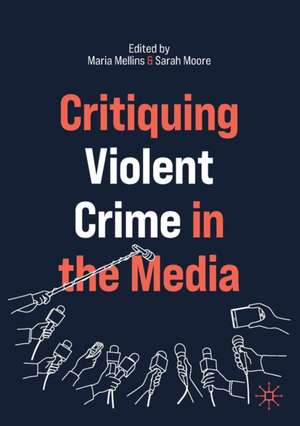Critiquing Violent Crime in the Media
Editat de Maria Mellins, Sarah Mooreen Limba Engleză Paperback – 11 dec 2021
Arranged into four sections, including: true crime trials, representations of victims, the consumption of serial killer narratives, and true crime spaces, each chapter explores different themes and topics across traditional and newer media. These topics include: emotion and appeals for justice in Making a Murderer, #MeToo and misogyny in crime narratives, true crime journalism being exploitative, the ethics of consuming dark tourism and the appetite for true crime, live streamed murder, and the ways in which true murder accounts might lend insight into other types of crime such as domestic violence and stalking. This book stimulates discussion on undergraduate courses in crime, media and culture as well as in film and media studies, and it also speaks to those with a general interest in true crime.
Preț: 327.33 lei
Nou
Puncte Express: 491
Preț estimativ în valută:
62.63€ • 65.57$ • 51.83£
62.63€ • 65.57$ • 51.83£
Carte tipărită la comandă
Livrare economică 07-21 aprilie
Preluare comenzi: 021 569.72.76
Specificații
ISBN-13: 9783030837570
ISBN-10: 3030837572
Pagini: 263
Ilustrații: XVII, 400 p. 15 illus., 14 illus. in color.
Dimensiuni: 148 x 210 x 30 mm
Greutate: 0.55 kg
Ediția:1st ed. 2021
Editura: Springer International Publishing
Colecția Palgrave Macmillan
Locul publicării:Cham, Switzerland
ISBN-10: 3030837572
Pagini: 263
Ilustrații: XVII, 400 p. 15 illus., 14 illus. in color.
Dimensiuni: 148 x 210 x 30 mm
Greutate: 0.55 kg
Ediția:1st ed. 2021
Editura: Springer International Publishing
Colecția Palgrave Macmillan
Locul publicării:Cham, Switzerland
Cuprins
1. Introduction, Sarah Moore And Maria Mellins.- 2. The Deceased-Accused And The Victim As A Commodity: Jimmy Savile As A Case Study To Examine The Role Of Real-Crime Documentary In Reproducing Violence As Entertainment, Susanna Menis.- 3. ‘Don’t Let Netflix Tell You What To Think!’: Debates On Getting To Know The Accused/Convicted In Making A Murderer And Other Injustice Narratives, George S, Larke-Walsh.- 4. From ‘Forensic Narratives’ To ‘Narratives Of Forensics’: Telling Stories About The Murder Of Gay Gibson, Alexa Neale.- 5. In Consideration Of Serial Violence: The Perils Of Repetition And Routine In ‘True Crime’ Documentaries, Sarah Moore.- 6. ‘Stay Sexy And Don’t Get Murdered’: Depictions Of Female Victimhood In Post-Me Too True Crime, Megan Hoffman And Simon Hobbs.- 7. Stalking, The Media And Raising Public Awareness, Maria Mellins.- 8. Human Trafficking And Coercive Control: Representations In Media And Challenges In Legislation, Carole Murphy.- 9. ‘That Photograph’ – Serial Killer As Modern Celebrity, Ian Cummins, Marian Foley And Martin King.- 10. Real-Life Criminals And Crime Fictions: Adapting The Serial Killer As Gothic Monster In TV Drama, Brigid Cherry.- 11. Gender, True Crime And The Violent Subject, Louise Wattis.- 12. Feeding The Fascination: Crime-Related Tourism And The True Crime Museum, Hannah Thurston.- 13. Exploring The Presence Of The Digital Detective Within The True-Crime Genre And Its Online Spaces, Farhana Irshad.- 14. Live Streaming Of Murder: Regulatory Responses And Challenges, Gregor Urbas.
Notă biografică
Maria Mellins is an Associate Professor in Criminology, Sociology and Screen Media at St Mary’s University. She is also an Independent Stalking Advocacy Caseworker (ISAC).
Sarah Moore is a Senior Lecturer in Sociology at the University of Bath, UK.
Sarah Moore is a Senior Lecturer in Sociology at the University of Bath, UK.
Textul de pe ultima copertă
This book explores the recent surge in true crime by critically exploring how murder and violence are represented in documentaries, films, podcasts, museums, novels and in the press, and the effects. From a range of contributors, it touches on a wide variety of topics overall and illustrates how examining true crime across the changing popular media landscape can contribute to important debates in contemporary culture and society. It encourages a critical eye towards understanding the harmful stereotypes, myths and misinformation that popular media can bring.
Arranged around four sections, including: true crime trials, representations of victims, the consumption of serial killer narratives, and true crime spaces, each chapter explores different themes and topics across traditional and newer media. These topics include: emotion and appeals for justice in Making a Murderer, #MeToo and misogyny in crime narratives, true crime journalism being exploitative, the ethics ofconsuming dark tourism and the appetite for true crime, live streamed murder, and the ways in which true murder accounts might lend insight into other types of crime such as domestic violence and stalking. This book stimulates discussion on courses in crime, media and culture as well as in film and media studies, and it also speaks to those with a general interest in true crime.
Caracteristici
Encourages critical discussions around the representation of true crime Brings together a range of unique and critical themes which have been under-explored Discusses how media representations of crime can inform/misinform public understanding of crime and society
